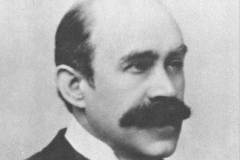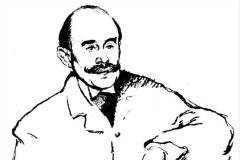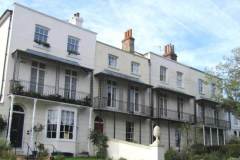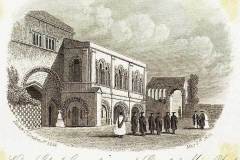Aesthete, Writer, King’s School Scholar
Walter Horatio Pater [images 1,2] was a writer and critic on art and the classical and Renaissance eras, and inspired many leaders of the 19th century aesthetic movement in England whose doctrine can be summarised as “art for art’s sake”.
Pater was born in east London the third of four children. His father, a general medical practitioner, died when Pater was two and the family moved first to Hackney and then Enfield where Pater went to the grammar school. In 1853 the family moved to Harbledown so that Pater could be a day boy at King’s School, Canterbury. They lived in one of the four houses of Harbledown Place built in 1824, now 17 Summer Hill [image 3].
- King’s and the Cathedral made a great impression on Pater which years later he used in a quasi-autobiographic fiction Emerald Uthwart. The story is set in Sussex but is obviously based on Canterbury. The eponymous hero walks to his new school through “the old ecclesiastical city” and after meeting his schoolfellows: “They disperse; flock out into the court; acquaint him hastily with the curiosities of the Precincts, the ‘dark entry,’ the rich heraldries of the blackened and mouldering cloister, the ruined overgrown spaces where the old monastery stood . . . are ready also to climb the scaffold poles always to be found somewhere about the great church, or dive along the odd, secret passages of the old builders, with quite learned explanations . . . of Gothic ‘late’ and ‘early,’ layer upon layer, down to round-arched ‘Norman,’ like the famous staircase of their school.” [image 4]
- Pater became a King’s scholar in late 1853. The following year his mother died leaving Pater and his two sisters at Harbledown in the care of Aunt Bessie, his father’s sister.
- Pater was attracted to High Church ritualism and loved saints’ days at King’s with their robed processions to the cathedral where in the choir “the melodious mellow-lighted space [is] always three days behind the temperature outside”. He never lost his love for ritual but by the time he left the school he had started to lose his faith.
- Pater left King’s in 1858 with prizes in Latin and Ecclesiastical History and an exhibition that enabled him to read classics at Queen’s College, Oxford. He only gained a second-class degree but was elected a fellow of Brasenose, Oxford, in 1864.
- He then started writing essays and articles on art and culture, concentrating on the Roman, Greek and Renaissance periods. These outlined the aesthetic ideal of living life for the moment, free from dogma. In 1873 a collection of these was published as Studies In The History Of The Renaissance with a conclusion that was denounced from pulpits and the press as promoting hedonism. But his writing was embraced by aesthetes such as Oscar Wilde, the poet Algernon Swinburne, and painters James Whistler and Dante Gabriel Rossetti.
- Pater died on 30 July 1894 of a heart attack brought on by pleurisy. Nowadays he is known to the general reader, if at all, only from footnotes and by his influence on other writers, but he is studied in universities and The International Walter Pater Society publishes a newsletter and organises conferences and workshops.
- And at King’s School the Classics department runs a programme of events under the auspices of the Pater Society.
Further reading: Oxford Dictionary Of National Biography; The Life Of Walter Pater, by Thomas Wright, 1907; Walter Pater, by Gerald Monsman, 1977.
JPD




